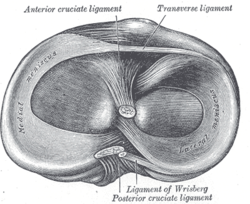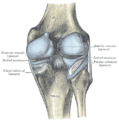This article includes a list of general references, but it lacks sufficient corresponding inline citations. (June 2015) |
| Lateral meniscus | |
|---|---|
 Knee from the side, with lateral meniscus simply labeled as "meniscus". | |
 | |
| Details | |
| Identifiers | |
| Latin | meniscus lateralis |
| TA98 | A03.6.08.002 |
| TA2 | 1885 |
| FMA | 44631 |
| Anatomical terminology | |
The lateral meniscus (external semilunar fibrocartilage) is a fibrocartilaginous band that spans the lateral side of the interior of the knee joint. It is one of two menisci of the knee, the other being the medial meniscus. It is nearly circular and covers a larger portion of the articular surface than the medial. It can occasionally be injured or torn by twisting the knee or applying direct force, as seen in contact sports.
Structure
The lateral meniscus is grooved laterally for the tendon of the popliteus, which separates it from the fibular collateral ligament.
Its anterior end is attached in front of the intercondyloid eminence of the tibia, lateral to, and behind, the anterior cruciate ligament, with which it blends; the posterior end is attached behind the intercondyloid eminence of the tibia and in front of the posterior end of the medial meniscus.
The anterior attachment of the lateral meniscus is twisted on itself so that its free margin looks backward and upward, its anterior end resting on a sloping shelf of bone on the front of the lateral process of the intercondyloid eminence.
Close to its posterior attachment it sends off a strong fasciculus, the ligament of Wrisberg, which passes upward and medialward, to be inserted into the medial condyle of the femur, immediately behind the attachment of the posterior cruciate ligament.
The lateral meniscus gives off from its anterior convex margin a fasciculus which forms the transverse ligament.
Variation
Occasionally a small fasciculus passes forward to be inserted into the lateral part of the anterior cruciate ligament.
Clinical significance
The lateral meniscus is less likely to be injured or torn than the medial meniscus. Diagnosis of lateral meniscus tear is done with McMurray's test. If a tear is detected, treatment depends on the type and size of the tear. Small tears can be treated conservatively, with rest, ice, and pain medications until the pain is under control, then exercise may be started with gradually increasing intensity, to improve range of motion and decrease swelling. More severe tears of the lateral meniscus require surgical repair or removal, which can often be done arthroscopically. Swelling and stiffness of the knee can occur when you have a torn lateral meniscus.
Additional images
This gallery of anatomic features needs cleanup to abide by the medical manual of style. |
-
Left knee joint from behind, showing interior ligaments.
-
Right knee-joint, from the front, showing interior ligaments.
-
Capsule of right knee-joint (distended). Lateral aspect.
-
Capsule of right knee-joint (distended). Posterior aspect.
-
Anterior view of knee.
-
Right knee in extension. Deep dissection. Posterior view.
-
Right knee in extension. Deep dissection. Posterior view.
-
Knee and tibiofibular joint. Deep dissection. Anterior view.
-
Knee and tibiofibular joint. Deep dissection. Anterior view.
-
Knee joint. Deep dissection. Anteromedial view.
-
Knee joint. Deep dissection. Anteromedial view.
-
Knee joint. Deep dissection. Anteromedial view.
-
Knee joint. Deep dissection. Anteromedial view.
-
Knee joint. Deep dissection. Anterior view
-
Knee joint. Deep dissection. Anterior view.
-
Knee joint. Deep dissection. Posterior view.
See also
References
![]() This article incorporates text in the public domain from page 343 of the 20th edition of Gray's Anatomy (1918)
This article incorporates text in the public domain from page 343 of the 20th edition of Gray's Anatomy (1918)
External links
- Anatomy figure: 17:07-09 at Human Anatomy Online, SUNY Downstate Medical Center
- "Anatomy diagram: 02240.009-2". Roche Lexicon - illustrated navigator. Elsevier. Archived from the original on 2012-07-22.
- lljoints at The Anatomy Lesson by Wesley Norman (Georgetown University) (antkneejointopenflexed)
























